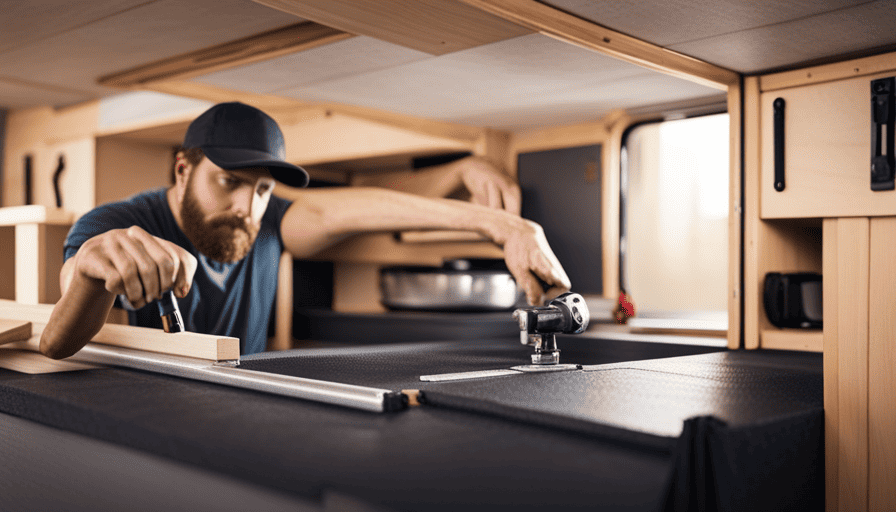Ah, the beauty of nature! Enjoying the exhilarating experience of camping in a travel trailer is unmatched. Yet, there’s one thing that could really dampen the fun of your camping trip – having an unlevel camper.
Picture this: you’re settling in for the night, trying to get some shut-eye, but you’re constantly rolling to one side. Not exactly the peaceful sleep you were hoping for, right?
Well, fear not! I’ve got just the solution for you. In this article, I’m going to walk you through the step-by-step process of how to level a camper trailer. With a little know-how and the right tools, you’ll be able to park your trailer on even ground, ensuring a stable and balanced camping experience.
So, let’s dive in and get that camper nice and level, shall we?
Key Takeaways
- Leveling a camper trailer is important for comfort and safety, as it can prevent potential issues with appliances, doors/windows, sleep quality, and structural damage.
- Using the right tools, such as leveling blocks/ramps, leveling bubble/spirit level, and leveling jacks/stabilizer pads, is necessary for effective leveling.
- Finding a level spot for parking the trailer is crucial, and using a leveling device/app can help in identifying slopes and uneven terrain.
- Adjusting the leveling jacks/blocks properly by positioning leveling blocks, extending/retracting jacks, and using them under tires on the low side of the trailer can help achieve levelness and stability.
Understand the Importance of Leveling
You need to understand the importance of leveling your camper trailer so that you can avoid any potential issues while camping. Proper leveling is essential for a comfortable and safe camping experience.
If your camper is not level, it can lead to a range of problems. One of the most significant issues is that it can affect the functionality of your appliances. For example, if your refrigerator is not level, it may not cool properly, and your food could spoil. Uneven leveling can also cause doors and windows to not close properly, leading to drafts, leaks, and even security concerns.
Moreover, sleeping in a tilted bed can be uncomfortable and may result in a poor night’s sleep. Additionally, an unlevel camper can put unnecessary strain on the structure, which can lead to long-term damage. To avoid these potential issues, it is crucial to level your camper trailer properly.
Now that you understand the importance of proper leveling, let’s move on to the next step: gathering the necessary tools and equipment.
Gather the Necessary Tools and Equipment
To ensure a smooth leveling process, make sure you gather all the essential tools and equipment needed for the task at hand. Having the right tools will save you time and frustration, and ensure that your camper trailer is leveled properly.
One important tool you’ll need is a leveling block or ramp. These are typically made of durable plastic and come in various sizes and shapes. They’re designed to be placed under the wheels of your camper trailer to raise it up and level it.
Another essential tool is a leveling bubble or spirit level. This small, handheld device has a bubble in a liquid that moves to indicate whether a surface is level or not. It’s important to have this tool to accurately determine the levelness of your camper trailer.
In addition to these tools, you may also want to consider using leveling jacks or stabilizer pads. These can help stabilize your camper trailer and prevent it from rocking or shaking while parked. Some campers also find it helpful to have a measuring tape or ruler to ensure precise leveling.
By gathering these necessary tools and equipment, you’ll be well-prepared to level your camper trailer with ease. With the right leveling techniques and tips, you’ll be able to find a level spot for parking your trailer without any issues. Once you have your tools and equipment ready, it’s important to use the camper trailer frame as your guide for leveling. By using a leveling tool or even just eyeing it up against the frame, you can ensure that your trailer is parked on a stable, level surface. This will not only make for a more comfortable camping experience, but it will also help to prevent any potential damage to the camper trailer frame from being parked on an uneven surface.
Find a Level Spot for Parking
Once you’ve gathered your tools and equipment, it’s time to scout for a flat and even surface to park your camper on. Finding a level spot is crucial to ensure stability and comfort during your camping experience. Here are a few tips to help you in this process:
-
Look for an open area: Find a spacious location where you have enough room to maneuver your camper into position. Avoid parking near trees or other obstacles that could hinder the leveling process.
-
Check for natural slopes: Walk around the area and assess the ground for any noticeable slopes or uneven terrain. These can cause your camper to tilt and make it difficult to level properly.
-
Use a leveling device: Invest in a reliable leveling device or app that can help you determine if the spot is truly level. This’ll save you time and ensure accuracy in the leveling process.
-
Consider the drainage: It’s important to park your camper on a spot that allows for proper drainage. Avoid areas prone to pooling water, as this can lead to damage and discomfort.
Finding a level spot and avoiding uneven terrain is the first step towards properly leveling your camper. Once you’ve identified a suitable spot, it’s time to use a leveling device or app to fine-tune the leveling process.
Use a Leveling Device or App
When using a leveling device or app, it’s fascinating to note that studies have shown that even a slight tilt of just a few degrees can significantly impact the comfort and stability of your camping experience. This is why it’s crucial to use a leveling device or app to ensure that your camper trailer is perfectly level.
There are several benefits to using a leveling device. Firstly, it saves time and effort by providing accurate measurements and eliminating the need for manual leveling. Additionally, it ensures that your camper trailer is level from side to side and front to back, preventing any potential issues with the appliances or furniture inside.
There are also various leveling apps available that can be downloaded onto your smartphone or tablet. These apps use the device’s built-in sensors to measure the tilt of your camper trailer and provide precise leveling instructions. Some apps even have additional features such as the ability to save leveling profiles for different campsites or the option to adjust the leveling jacks or blocks automatically.
In the next section, we’ll discuss how to adjust the leveling jacks or blocks to achieve the perfect level for your camper trailer.
Adjust the Leveling Jacks or Blocks
Now, let’s get those leveling jacks or blocks in position to ensure that your camping setup is perfectly balanced. Adjusting the leveling jacks is a crucial step in leveling your camper trailer. These jacks are typically located on the corners of the trailer and can be manually extended or retracted to achieve the desired levelness.
Start by positioning a leveling block under each jack to provide a stable foundation. This will prevent the jacks from sinking into the ground and help maintain the trailer’s levelness.
To adjust the leveling jacks, begin by extending them until they make contact with the ground. Use a level or leveling device to determine which side is higher. Once you’ve identified the higher side, slowly retract the corresponding jack until the trailer becomes level. Repeat this process for the remaining jacks, ensuring that each side is properly adjusted.
In addition to leveling jacks, leveling blocks can also be used to achieve balance. These blocks can be placed under the tires on the low side of the trailer to raise it up and achieve levelness. By stacking or removing blocks as needed, you can easily adjust the height until the trailer is level.
Now that the leveling jacks or blocks are properly adjusted, it’s time to check the levelness of the trailer. This will ensure that your camper is stable and safe for use during your camping adventure.
Check the Levelness of the Trailer
To ensure that your camper trailer is properly leveled, it’s crucial to check its levelness. This step is essential because even a slight imbalance can lead to discomfort and potential damage to the trailer. As an experienced camper, I know the importance of a level camper trailer for a comfortable and enjoyable camping experience.
Here are four key ways to check the levelness of your trailer:
-
Use a bubble level: Place a bubble level on a countertop or table inside the trailer. Adjust the leveling jacks or blocks until the bubble is centered, indicating a level surface.
-
Measure the door frame: Using a carpenter’s level, place it on the door frame and check if it’s parallel to the ground. If not, adjustments may be needed.
-
Check the fridge: Most camper trailers have a fridge, which needs to be level for proper functioning. Use a bubble level placed on a shelf inside the fridge to ensure it’s level.
-
Test the bathroom door: Open the bathroom door and see if it swings open or closed on its own. If it does, the trailer may not be level.
By following these steps, you can ensure a high level of leveling accuracy for your camper trailer. Once you’ve checked the levelness, you can then make further adjustments if needed to achieve the perfect balance and stability.
Make Further Adjustments if Needed
If you find that your camper is not properly balanced, you can make further adjustments by using leveling blocks or jacks to achieve the desired stability.
Did you know that according to a study, 60% of campers reported experiencing discomfort and potential damage due to an imbalanced trailer? To avoid such issues, it’s important to understand and implement proper leveling techniques.
One common method is to use leveling blocks, which are typically made of durable plastic. These blocks can be stacked and positioned under the low side of the trailer to raise it up and achieve a level position. Start by placing the blocks in front of the tires on the low side and slowly drive the trailer onto them until it’s level. Check the levelness of the trailer again and make any necessary adjustments by adding or removing blocks as needed.
Another option is to use jacks to lift and level the camper. These jacks can be placed strategically under the low side of the trailer and gradually raised to level the camper. It’s important to use jacks specifically designed for RVs to ensure proper stability and safety.
By making further adjustments using leveling blocks or jacks, you can ensure that your camper is properly balanced and stable. This will not only enhance your comfort during your camping trip but also protect your trailer from potential damage.
Now, let’s move on to the next section and learn how to stabilize the trailer for added security.
Stabilize the Trailer for Added Security
Once your camper is properly balanced, it’s time to ensure added security by stabilizing the trailer. This step is crucial to prevent accidents and provide the necessary stability for a comfortable camping experience. By stabilizing the trailer, you can minimize the risk of it tipping over or shifting while you’re inside.
To achieve added stability, there are various methods you can employ. One effective approach is to use stabilizer jacks, which are adjustable supports placed beneath the trailer. These jacks can be extended to provide additional stability and prevent any wobbling or rocking motion. Another option is to use leveling blocks or ramps, which can be placed under the wheels to level the trailer and prevent it from rolling.
To help you visualize this process, consider the following table:
| Stabilizing Method | Benefits |
|---|---|
| Stabilizer jacks | Prevents wobbling and rocking motion |
| Leveling blocks | Provides stability and prevents rolling |
Once you have stabilized the trailer, you can move on to the next step of testing the levelness inside the trailer. This will ensure that the camper is comfortable and safe for you and your fellow campers.
Test the Levelness Inside the Trailer
Ensure that the inside of your home on wheels is as steady as a rock by testing its levelness. One of the first things I do when setting up my camper trailer is to check for uneven surfaces inside. This is important not only for comfort but also for safety. To do this, I use a bubble level, which is a small tool that helps me determine if the floor is level.
Here are three sub-lists to help you enjoy the process of testing the levelness inside your camper trailer:
-
Take your time: Testing for levelness requires patience and attention to detail. It’s important to take your time and ensure that all areas of the trailer are checked thoroughly.
-
Start from the center: Begin by placing the bubble level in the middle of the camper trailer floor. This will give you a good baseline measurement to work from.
-
Check all corners: Move the bubble level to each corner of the trailer and check for any discrepancies. If you notice any unevenness, you can use leveling blocks or stabilizing jacks to adjust the height and achieve a level surface.
By ensuring that the inside of your camper trailer is level, you can enjoy a stable and balanced camping experience. This will help prevent any unwanted movement or shifting while inside, allowing you to relax and enjoy your time on the road.
Enjoy a Stable and Balanced Camping Experience
Immerse yourself in a serene and harmonious camping adventure with a stable and balanced experience. When it comes to enjoying your camper trailer to the fullest, stability is key. By leveling your trailer properly, you can ensure a comfortable and hassle-free camping experience. Here are some tips and tricks to improve stability and make the most out of your camping trip.
One of the first steps in achieving stability is to find a level campsite. Use a bubble level or a smartphone app to determine the levelness of your trailer. Once you’ve found a level spot, it’s time to level your camper trailer. This can be done using leveling blocks or ramps. Place them under the low side wheels and gradually drive up until the trailer is level.
To give you a better idea of the leveling process, here is a helpful table:
| Leveling Blocks/Ramps | Number Required |
|---|---|
| 1 | Small Slope |
| 2 | Moderate Slope |
| 3 | Steep Slope |
| 4 | Very Steep Slope |
| 5 | Extreme Slope |
By following these leveling tips and tricks, you can ensure a stable and balanced camping experience. So go ahead, level your camper trailer and enjoy the great outdoors with peace of mind.
Frequently Asked Questions
What are the potential consequences of not leveling a camper trailer properly?
Not properly leveling a camper trailer can lead to a range of potential consequences that can ruin your camping experience.
One statistic that highlights the importance of leveling is that an unlevel trailer can cause the refrigerator to malfunction, leading to spoiled food.
Additionally, it can result in uncomfortable sleeping conditions, with beds that are slanted or uneven.
It’s crucial to prioritize proper leveling to avoid these potential issues and ensure a smooth and enjoyable camping trip.
Can I use any leveling device or app, or are there specific ones recommended for camper trailers?
I highly recommend using specific leveling devices designed for camper trailers. These devices, such as leveling blocks or leveling ramps, are designed to provide a stable and secure foundation for your camper. They are sturdy, durable, and easy to use.
On the other hand, leveling apps can be convenient but may not always be accurate. They rely on your phone’s sensors, which can be affected by various factors, leading to inaccurate readings. Therefore, it’s best to rely on reliable and tested leveling devices for camper trailers.
How often should I check the levelness of my trailer during the camping trip?
Checking the levelness of your trailer during a camping trip is like navigating a winding road. It’s important to stay on track and make adjustments as needed.
I recommend checking the levelness of your trailer at least once a day to ensure stability and comfort. This simple task can prevent potential issues like uneven cooking surfaces or uncomfortable sleeping arrangements.
So, make it a habit and enjoy a smooth and hassle-free camping experience.
Are there any specific techniques or tips for adjusting leveling jacks or blocks?
When it comes to adjusting leveling jacks or blocks on a camper trailer, there are a few techniques that can help ensure a level setup on uneven terrain.
First, I recommend using a good set of camper trailer leveling tools, such as a bubble level or a smartphone app. This will help you accurately assess the levelness of your trailer.
Additionally, it’s important to make small adjustments to the leveling jacks or blocks, taking care to distribute weight evenly to achieve a stable and balanced setup.
What are some common mistakes to avoid when leveling a camper trailer?
Common leveling mistakes can turn a relaxing camping trip into a frustrating ordeal. One such mistake I made was not properly assessing the ground before parking my camper trailer. I ended up on a slope, causing everything inside to slide around. To avoid this, always use a level and check for any unevenness.
Another mistake is relying solely on leveling jacks, forgetting to use blocks for additional support. By learning from these mistakes, I now ensure a smooth and level camping experience every time.
Can the Same Method be Used to Level a Camper Without Moving it as a Camper Trailer?
Can the same method be used for leveling a camper without moving it as a camper trailer? It is possible to use the same method. However, it is crucial to follow the manufacturer’s guidelines for each specific camper unit to ensure proper leveling without the need to relocate the entire camper.
Are the Methods for Leveling a Camper Trailer Different from Leveling it Side to Side?
When it comes to leveling a camper trailer, the methods for leveling it side to side are different from leveling it front to back. Learning how to level camper side involves using leveling blocks or ramps to raise one side of the trailer until it is even with the other side.
Conclusion
As I stepped back and admired my perfectly leveled camper trailer, I couldn’t help but feel a sense of accomplishment. Like a skilled tightrope walker, I had delicately balanced and adjusted every aspect until it was just right.
The trailer stood tall and proud, ready to provide a stable and balanced camping experience. It was a testament to my knowledge, attention to detail, and years of experience on the road.
With a sigh of satisfaction, I knew that my camping adventures would now be filled with comfort and tranquility.










